Reuters Report Digital News: 5 highlights to bookmark
Written by
Kinga EdwardsPublished on

Is 2020 the year of reports? We don’t know, but with the number of great reports being released by publishers around the world, that’s the impression!
This time, we take a closer look at the Reuters Digital News report, which deals with the subject of information availability. How do people read the news? What kind of media do they trust? Are they afraid of disinformation? What are the challenges facing politicians, publishers, and journalists?
| How was the research made: This study has been commissioned by the Reuters Institute for the Study of Journalism to understand how news is being consumed in a range of countries. Research was conducted by YouGov using an online questionnaire at the end of January / beginning of February 2020. |
We have selected some interesting conclusions from the report – we present them below.
News media in Germany
How often and where do Germans read the latest news?
Offline channels
ARD News and ZDF News, i.e. popular German TV stations, lead the ranking. Regional and local publishing houses are third and RTL News is fourth. The ranking also includes other interesting offline items, such as free city newspapers or radio stations.
Online channels
Spiegel is the most popular one, but many other media are on its heels. It is also worth paying attention to the frequency of checking the news – weekly or at least three times a week.
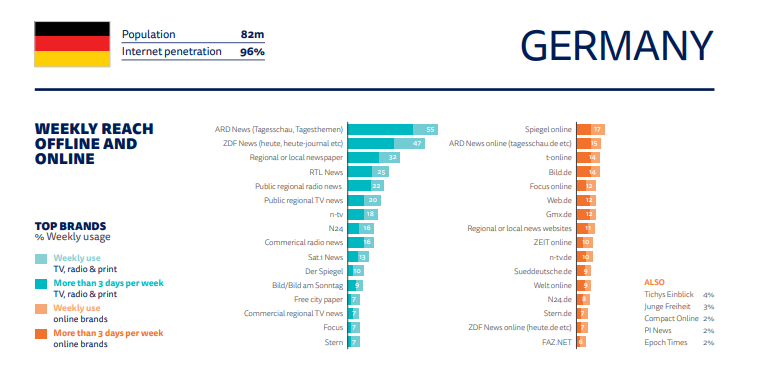
The use of the media to check news is another interesting graph. It turns out that television and the online world (including social media) enjoy a similar interest, with a predicted slight advantage towards television, caused by the outbreak of the pandemic and information being checked by all target groups. The popularity of the printed press has been declining significantly for 7 years – from 63% to just the forecast 26%.
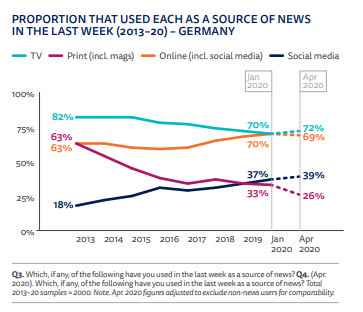
Compared to other countries, another regularity can also be noticed – Germany is slightly less active in social media when it comes to perceiving it as a source of information, but as many as 41% of them used the radio for the latest information on Covid-19, 72% watched it on to this end, television.

Germans go mobile
Over the last seven years, the consumption of messages has also changed somewhat. While 71% of Germans used computers to read the news 7 years ago, in 2020 only 49% of Germans still use computers. One can notice a huge jump in popularity of browsing information on mobile devices, in particular on phones. In 2013 it was 22%, in 2020 it is 58%.
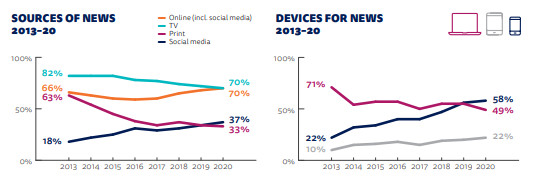
German media to trust
2020, you can see a decrease in the credibility of the media in the eyes of the audience. Come as a whole, trust in the media has dropped by 2%, in the case of brands, trust in them is still satisfactory for many.
The most popular – and trusted by recipients – are public media such as ARD and ZDF. Regional press releases are equally popular. Although Bild is an immensely popular publishing house in Germany, it enjoys the lowest level of trust – just 20%, against 58% of distrust.

Social media as a news source
Although the most popular social media channel by Germans is Whatsapp, followed by YouTube, when it comes to obtaining information, another platform is the most popular. I am talking about Facebook, which is used by 22% of German recipients to check the latest news. The top six social media channels also include Instagram, Twitter and Messenger, owned by Facebook.

But how do younger target groups use social media? (18-24) It is worth analyzing this on data compiled with other countries, and also including other social media platforms – such as Snapchat and TikTok. It turns out that as many as 38% of German recipients aged 18-24 used Instagram for news related to the coronavirus, 10% looked for it on Snapchat, and 8% – on TikTok.
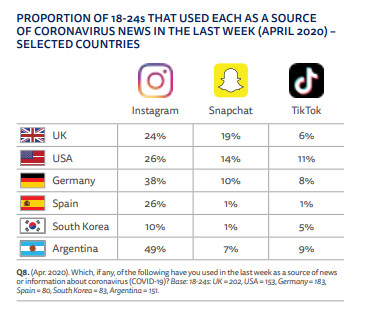
Sentiment to local media
Germans treat their regional media with a certain amount of sentiment and great trust. This is indicated by Reuters research.
Compared to the United States, German audiences have a special affection for their regional media and are interested in local news.
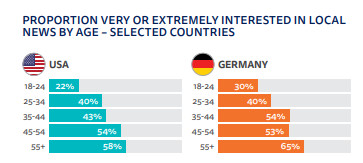
Reuters research also shows that a lot of German audiences in the world simply… would miss local publications. Compared to other countries (see chart below) – such as the US, UK or even the Philippines, 54% is a huge audience share. By comparison, in the UK only 25% of the audience would miss their local news.
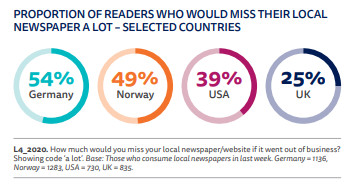

To wrap up
It is worth remembering the strong traditions of the Germans – their love of reading (“strong reading country”) and regionalism. Although the offline world in Germany is doing very well and has its followers, we should not forget about the online world, which is becoming more and more at home in our environment. Just look at the statistics on social media, including the latest “stars” – Snapchat or TikTok. We hope you will find our insights useful in planning or verifying activities. Good luck!


